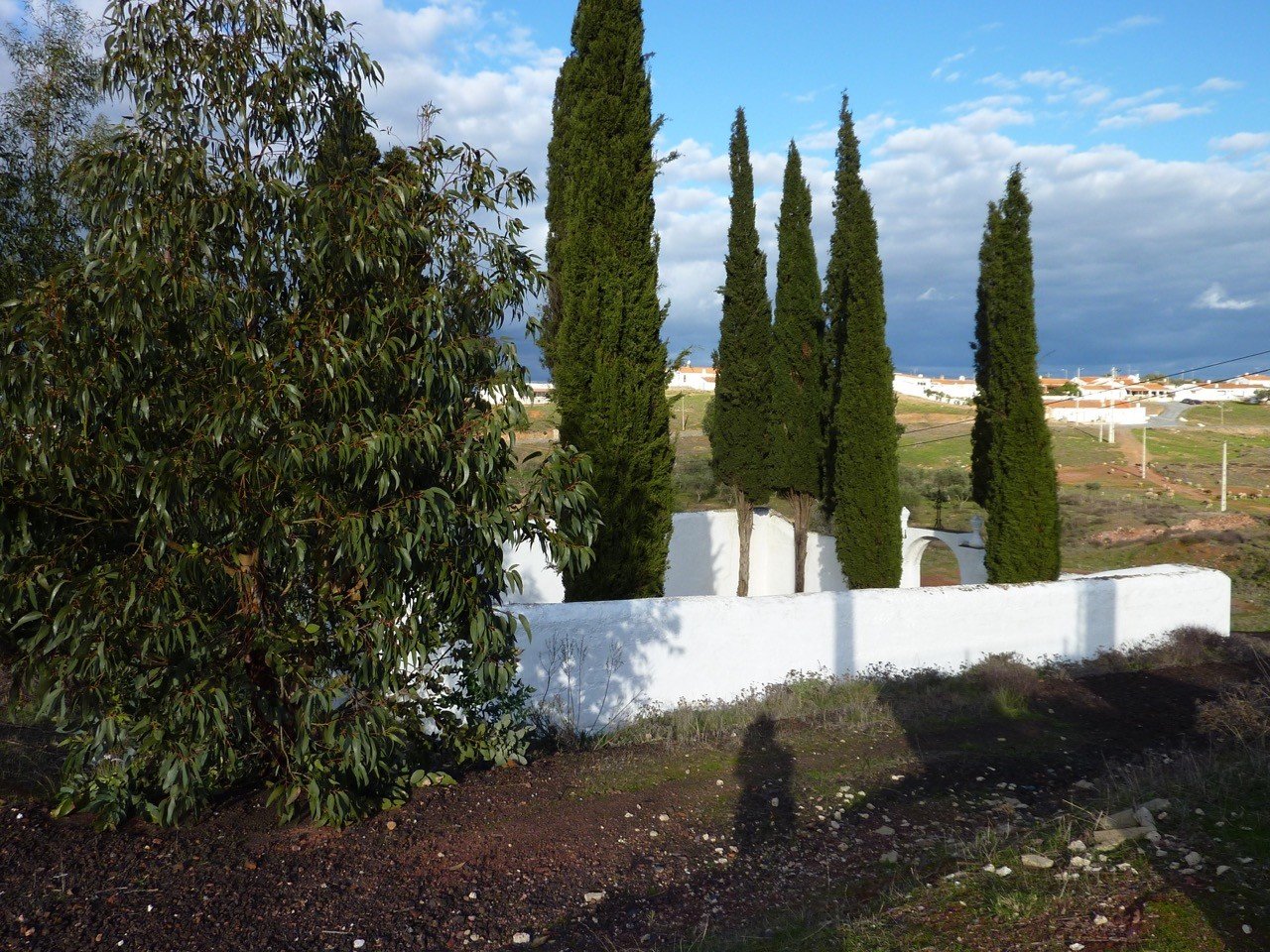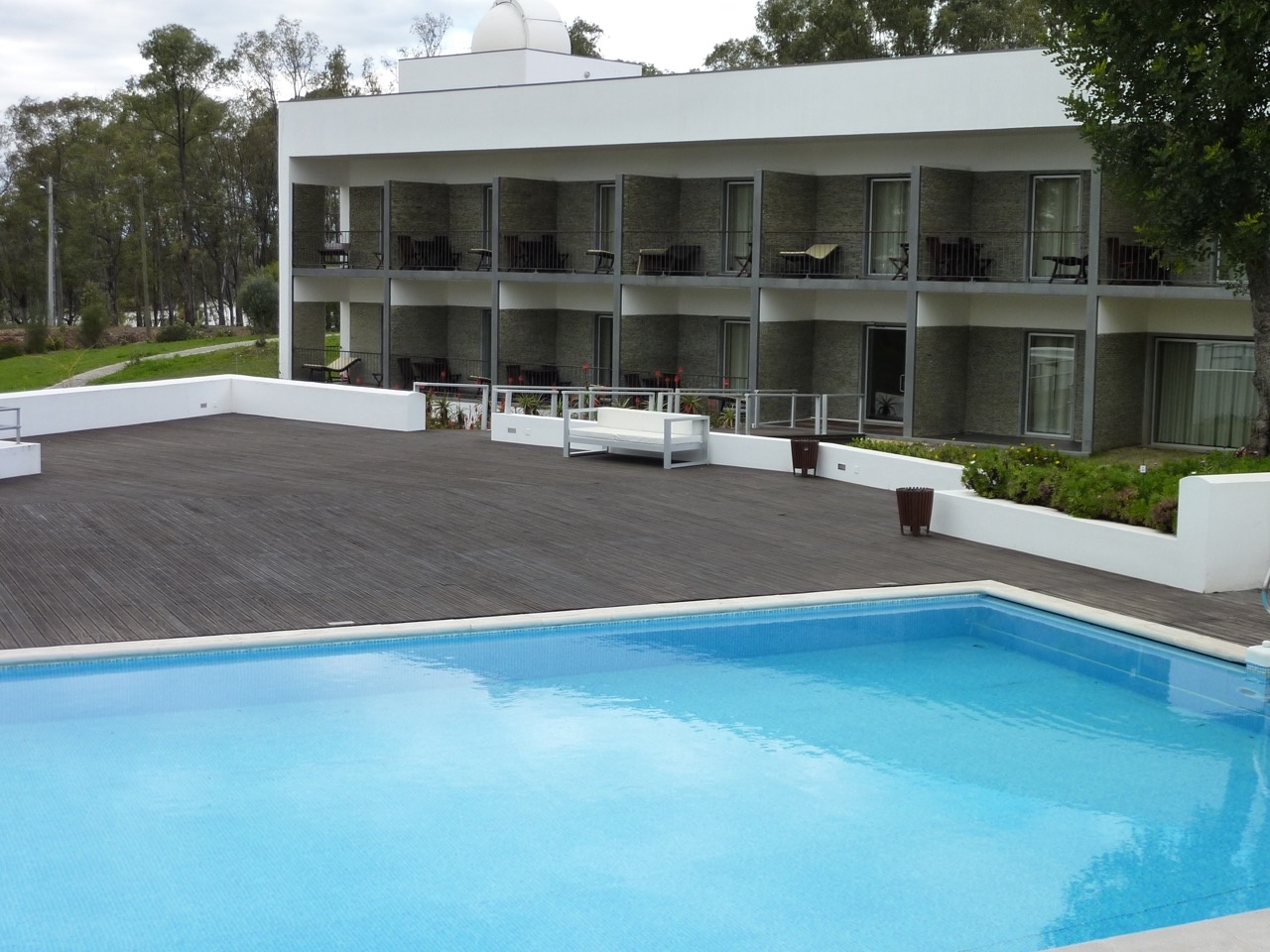Lynne Booker
A Terrific Splendour: The Mine of São Domingos. Colours of the rainbow - Sandy reds and yellows, grape and aubergine purples, sage greens. Dark black water with a hint of coppery hissing death. Dead grey areas of cracked landscape with here and there scraps of green struggling through.

Derelict buildings and tracks of flattened earth that mark the passage of the railway. The Mine of São Domingos. I´ve visited many times yet I am drawn back again and again to experience its particular and peculiar majesty.
Industrial landscapes
Industrial archaeology has always fascinated me. Human activity changes the economy, the social lives of people, the landscape. Everything. Perhaps it is the bleakness of some landscapes that shock: railways that are no longer used, spoil heaps that are barren; villages that are empty of people; shops that are boarded up; a church far too big for the present population; an empty school; plants trying to re-establish themselves amongst industrial poisons; the unseeing windows of ruined buildings.
One of the biggest mines in Europe
From Alcácer do Sal, through the Alentejo to Rio Tinto in Huelva Province of Andalucia, lies a band of rock 250 km long and between 30 - 60 km wide. The rock contains pyrites, zinc-blende, galena, arseno-pyrites and chalcopyrites. It is probable that the Phoenicians mined for copper and silver around São Domingos here in the south east Alentejo. The Romans certainly did mine in the area, and the mine was rediscovered in 1854 when Nicolau Biava recognised the spoil created from the Roman workings. La Sabina, a French company, registered the mine but it was an English company, Mason and Barry, which in 1859 took out the licence to exploit the mine. At times during the 107 years that the mine at São Domingos was active, it was one of Europe´s biggest in terms of output and numbers employed and at its peak, 16,000 people were associated with the mine. Initially the workers were Italian, Spanish, French and English but very quickly men from the Alentejo, the Algarve and the Beiras took over and the workers were soon all Portuguese, whereas the managerial staff at the mine were almost exclusively British. During its lifetime over 25 million tons of ore were taken from the ground. From 1859 to the end of World War I copper was the main target mineral but as the demand grew for sulphuric acid in Europe´s growing chemical industry, sulphur became more important. Much of the sulphur was sent to either to Swansea in Wales or to Barreiro on the Tagus.
Village Relocation as the Landscape Changes
In the mid 1860s owners Mason and Barry had to take radical measures to improve productivity in order to ensure the mine´s economic survival. What they proposed was to convert the underground workings to opencast methods. The company sought and obtained governmental permission to lop off the hill on which the ancient hermitage, newly constructed village and mine offices stood, to relocate the village and to open a vast pit. Seven dams were built to provide water for the processing the ores and the Tapada Pequena and Tapada Grande are still there today. The government ordered trees to be planted to mask the massive engine houses and other mine buildings and the company first planted pines. This species did not survive the poisonous atmosphere, and Mason and Barry substituted the eucalyptus which are still greatly in evidence today.

In the new village (finished around 1880), the mineworkers eventually occupied three barrios with houses made of taipa and the water supply, ovens and latrines were all shared. Managers lived in brick built houses and the Manager of the mine lived in the main offices which were referred to as the palácio. The management staff and their families enjoyed the use of a tennis court and beautiful gardens. Managers had exclusive use of one of the islands in the centre of theTapada Grande. The company built a church, a school a theatre, the first electricity station in the province and the first telephone exchange. São Domingos was not exactly a model village like those of John Cadbury or Joseph Fry and resembled more a British mining village, but whitewashed. Working conditions and the poisonous environment meant that life here for the ordinary worker was never comfortable. Because it was considered such an unattractive and dangerous place, the managers at the mine, engineers, and doctors (who were normally all British) were allowed two weeks leave for every 3 months of service at São Domingos.

Trains and Boats and Complaints
In order for the mine to operate profitably, Mason and Barry had to guarantee the removal of thousands of tons of ore from the remote Alentejo to the marketplace The company applied for permission to construct a tramway which became the first private tramway in Portugal. In the years 1859 – 1862, 17 km of track and 4 tunnels were built between the mine and the river port at Pomerão. Motive power was supplied by mules until in 1864 the first locomotive, named Estiphânia, came into use - much to the disgust of the thousand muleteers whose livelihoods were at stake! Over the life of the mine 37 locomotives hauled the mineral, of which two were built at São Domingos. Some cargo boats took the ore down to the mouth of the river and there transshipped it onto ocean freighters; other freighters made their way upriver to Pomerão itself, often bringing English engineering supplies for the mine and other consumable goods for this marooned British community. In 1864, 563 ships brought in English supplies to Pomerão and took out the ore. The River Guadiana is still tidal in this part and tides treacherously move the muds and sands around on the river bed; it was necessary to employ river pilots. Over the life of the mine, Mason and Barry undertook the dredging of the river between Pomerão and Vila Real de Santo António.
Industrial Inferno
With the opening of the mine, a quiet, agricultural area in the Alentejo with its own shrine to São Domingos on top of the hill changed into a hive of noise, movement, danger and poisonous fumes. Mason and Barry was the major regional employer. In 1861 there were 400 workers and from 1862 and through the 1870s up to 5,000 people were employed as a direct result of the mineworking. Before the company mastered the problem of drainage in the mine, the mineworkers were employed for only 9 months of the year because during the 3 winter months the mine was too wet to work. The dangers of working, the loss of livelihood in the winter months, the change to mechanisation of the tramway made for huge social and economic problems. The presence of nearly 50% sulphur in the ore caused immense human problems. Sulphur easily becomes acidic in the presence of water, and rotted mineworkers´clothes and lungs. The copper in the ores also caused throat problems. And tuberculosis was rife. There were of course accidents. One visitor to the mine in 1929 noted that the mine hospital recorded 5 work accidents per day. São Domingos was also a border town subject to violence and smuggling similar to that of the Wild West in the US. A working mine requires explosives, and as miners have a reputation as troublemakers, it was always considered necessary for a substantial police force to be present at the mine. In 1865 there were 25 police in São Domingos: in 1874 there were 50 and sometimes there was a need to bring police in from Beja and Vila Real de Santo António, especially when there were strikes or national unrest as in 1907 amd 1932.
Not all doom and gloom
On Sundays mineworks were allowed to visit the English part of the village where they could listen to the music played in the bandstand by the company endowed band. Mason and Barry also built a football field in the 1950s for the two village sides, Guadiana (founded 1900, playing strip green and white hoops, black shorts) and São Domingos (founded 1922, playing strip red shirts, white shorts). A plaque on the outside of the ground records a visit made to São Domingos by the legendary Eusébio in 1986. The villagers of São Domingos celebrate two major festivals with processions. First in honour of São Domingos (7 August) and on 4 December for Santa Bárbara, the patron saint of mineworkers.
The End

The efforts of the English James Mason were typical of the Victorian entrepreneur replete with English capital to invest. In the modern hotel, you may still see the hat worn by D Pedro V on his vist to the mine, and the king showed his appreciation by awarding to James Mason the honour of Comendador do Ordem de Cristo and the titles Barão de São Domingos, Visconde de São Domingos and Conde de Pomerão. For the mineworkers working in horrendous conditions employment in the mine was better than no work at all, but by 1966 the pyrites had exhausted and as the mine was no longer viable it was closed. The workforce was understandably bitter, and there was vandalism on the site and some desecration of the English cemetery on the edge of the village. Environmentally too there is a still huge problem - land that still cannot be reclaimed and a poisonous pit full of toxic, contaminated water. The residuary owners of the site, La Sabina Mining Company, converted the Manager´s palácio into a luxury hotel, which still contains many of the books, photographs, furniture and artefacts from the old palace. It is a magnificent blend of the luxurious old and the comfortable new. The hotel benefits from a modern pool, beautiful gardens and lawns on which there is a croquet court. The tennis court has not been restored – the net hangs forlornly and weeds sprout near the bandstand. The Câmara has created a lakeside beach on the Tapada Grande and in the summer the shallow, warm water, creamy sand and lakeside bar attract many a local as well as the grey nomads in their camper vans. A typical miner´s house has been converted into a small museum which also houses the office of the Coordinator of the Fundação Serrão Martins who is busy archiving information about the mine. At the museum, it is possible to arrange both a guided tour of the mine site and the railway down to the old port of Pomerão and also a visit to the Cine-Teatro which houses more artefacts and information.
For me it is ironic that a visit to the Estalagem São Domingos is always restful – the ghosts of past mineworkers are quiet ones!
